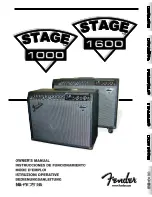
9
Caution
2
Place the ball (on the end of the string) in the
notch on the adjuster. Make sure the ball is prop-
erly inserted in the adjuster’s notch.
3
Insert the other end of the string into the hole
on the tuning peg. Ensure that the string is wound
on the right side of the hole for the 1st (E) and
2nd (A) strings, and on the left side of the hole
for the 3rd (D) and 4th (G) strings. Next, check
the bridge does not fall over as you wind the
strings. Ensure that the strings pass over the cor-
responding slits on the top of the bridge. (Make
sure that the bridge is standing vertically.)
The 1st string (E) has a protective tube on it.
Make sure the tube is placed on the bridge as
shown in the illustration.
4
Use a piano, tuning fork, tuner, etc., and adjust
the pitch of each string using the tuning pegs.
5
Finally, use the adjuster to fine tune the strings.
Adjuster’s notch
Ball
Ball
String
Wound to the left
Wound to the right
3rd string (D)
2nd string (A)
Rotate the
tuning peg
as shown
Rotate the
tuning peg
as shown
1st string (E)
4th string (G)
If the adjuster is too loose, it could
produce noise while playing.
Don’t loosen too much.
1st string (E) protective tube.
Adjuster
• When the instrument is not going to be used for an extended period of time, loosen the strings until
the pitch drops a whole tone.
02_sv130_e0.pm65
08.6.10, 10:37 AM
9
Black
































